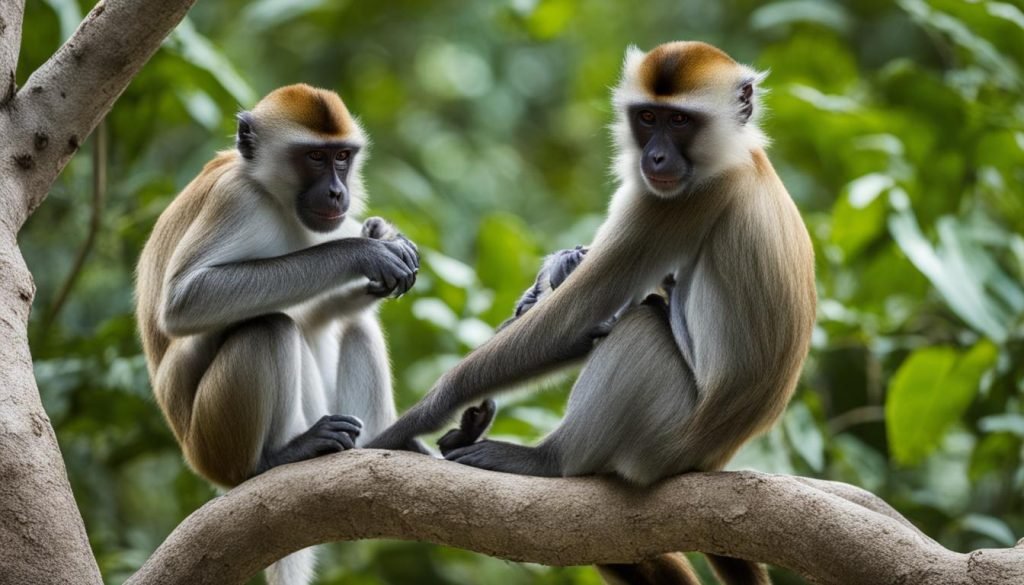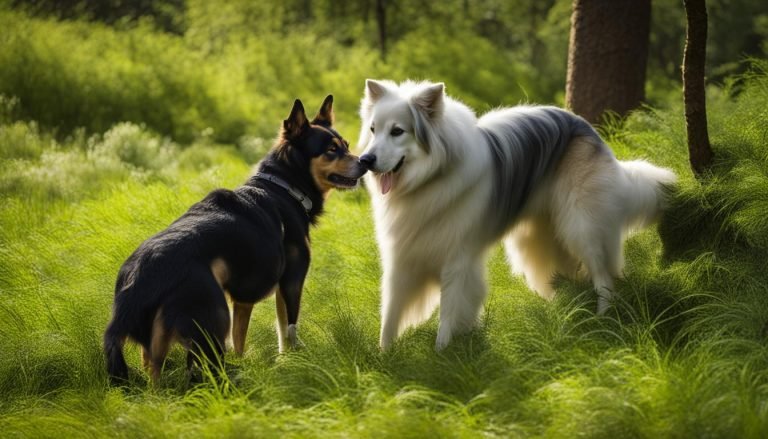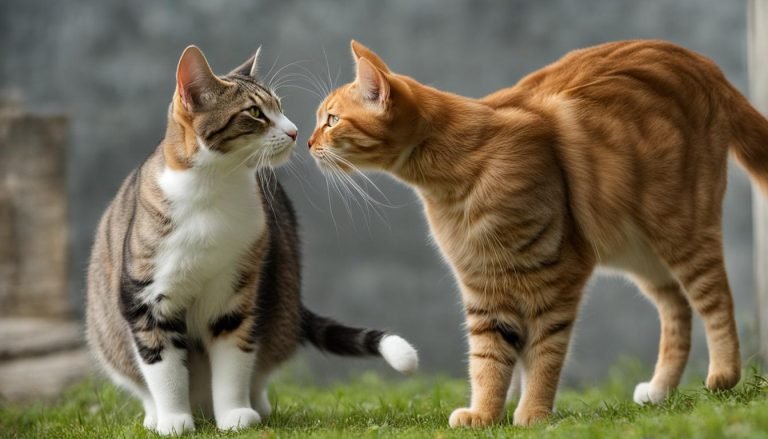How Do Monkeys Mate? – Explained
Monkeys are fascinating creatures with a complex social structure. One of the most intriguing aspects of their lives is their mating process.
How do monkeys mate? What are their breeding habits? What goes into the monkey reproduction process? In this article, we will explore the fascinating world of monkey mating and reproduction.
Key Takeaways:
- Monkey mating is a complex process that varies across different species.
- Monkey mating behaviors include courtship rituals and unique displays of sexual behavior.
- Monkeys have specific breeding seasons and reproductive cycles.
- Mate selection among monkeys is influenced by various factors.
- Understanding monkey reproduction is crucial for conservation efforts.
Understanding Monkey Mating Behaviors

Monkeys exhibit diverse mating behaviors. These behaviors have evolved in response to various environmental and social factors. In this section, we will discuss some of the interesting mating behaviors of monkeys and explore their reproductive cycle.
Sexual behaviors: Male monkeys demonstrate their sexual interest in females through various actions such as grooming, presenting gifts, and chasing females. Females tend to be selective when choosing their mates, and they often prefer males with strong social status.
Courtship rituals: Courtship behaviors among monkeys are sometimes elaborate and can involve several steps. For example, male Mandrills engage in threatening displays to attract females, while male Geladas engage in vocalizations and head-bobbing.
Reproductive cycle: The reproductive cycle of monkeys involves several stages, including estrus (the period when females are receptive to mating) and gestation (the period of pregnancy). The timing of these stages can vary by species and is influenced by factors such as food availability and social interactions.
To better understand monkey mating behaviors, scientists have conducted extensive research. Their findings have contributed to our knowledge of primate reproduction facts. For example, studies have shown that certain monkey species exhibit monogamous mating behaviors, while others engage in polygamous mating.
“Monkeys exhibit diverse mating behaviors. These behaviors have evolved over time in response to various environmental and social factors.”
Overall, studying monkey mating behaviors is important for understanding primate reproduction facts and the evolution of these fascinating creatures. In the next section, we will explore monkey breeding seasons and reproductive cycles.
Monkey Breeding Seasons and Reproductive Cycles

Monkeys, like many animals, have specific breeding seasons and reproductive cycles. These cycles are influenced by various factors, including diet, climate, and social behavior. Understanding these cycles is critical for conservation efforts and the survival of these remarkable creatures.
The Impact of Breeding Seasons
Most monkey species have a specific time of year when they mate, known as the breeding season. This season is typically influenced by environmental factors such as daylight hours and food availability. In some species, breeding seasons occur twice a year, while in others, mating can occur year-round.
To ensure successful reproduction, males will often compete with each other for access to females. Dominant males typically have the best chance of mating, while subordinate males may have to wait until the alpha males have had their turn.
The Monkey Reproductive Cycle
The monkey reproductive cycle is a complex process that involves various stages, from ovulation to gestation and childbirth. The length of this cycle varies by species, with some monkeys having much longer gestation periods than others.
During the mating season, female monkeys will typically go into heat, a period of increased fertility that lasts several days. If a female mates during this time, she will ovulate and become pregnant. The gestation period can range from four to six months, depending on the species. After birth, the mother will typically care for the newborn, providing it with nourishment and protection.
Conservation Efforts
Understanding monkey breeding seasons and reproductive cycles is critical for conservation efforts. Conservationists use this knowledge to identify critical habitats and breeding grounds, which can be protected from human encroachment and other threats.
Researchers are also studying the reproductive cycles of monkeys to develop breeding programs for endangered species. By identifying factors that influence the mating process, scientists may be able to improve captive breeding programs and increase the survival rates of endangered species.
“Understanding the reproductive cycles of monkeys is crucial for ensuring the survival of these remarkable creatures.”
Monkey Mating Rituals and Courtship Displays

Monkey mating rituals and courtship displays are fascinating to observe. Courtship behaviors in monkeys can range from simple displays of affection to elaborate mating rituals that involve dancing, vocalizations, and even gifts.
Male monkeys often engage in competitive behaviors to display their dominance and attract females. This can include chest beating, barking, and chasing other males away. Conversely, females may display their receptiveness to mating by presenting themselves in a particular pose or offering food to the male.
One of the most intriguing courtship displays can be observed in the Japanese macaque species, where males will offer females food items as a part of their courtship ritual. The female may accept or reject these advances, depending on a variety of factors, including the male’s social status and physical condition.
| Courtship Behavior | Monkey Species |
|---|---|
| Chest-beating, vocalizations | Gorillas |
| Food offerings | Japanese macaques |
| Scent marking, grooming | Capuchin monkeys |
Interestingly, some monkey species, such as bonobos, engage in sexual behavior not only for procreation but also for social bonding purposes. Bonobos are known for their sexual promiscuity, with both males and females engaging in sexual behavior with multiple partners as a way to bond and establish social cohesion.
“Sexual behavior is a key component of social life in bonobos and plays a role in reducing social tensions and promoting social bonds.”
When it comes to mating, monkeys exhibit a remarkable range of behaviors and rituals that are worth observing. Whether it’s the gorilla’s thunderous chest-beating or the Japanese macaque’s food offerings, each species has its unique way of attracting mates and establishing social bonds.
Factors Affecting Monkey Mate Selection

Monkeys exhibit a diverse range of sexual behaviors, and their breeding habits are influenced by different factors. While physical attributes, such as size and coloration, can play a role in mate selection, monkeys also consider social hierarchy and behavior.
Research has shown that dominant males are often preferred by females, possibly due to their ability to provide better protection and resources. In some species, females may also engage in sexual behavior with multiple males, leading to competition for access to fertile females.
Additionally, social bonds and affiliations play a significant role in monkey mate selection. In some species, individuals may form long-term pair bonds, while in others, females may form social groups to assist in raising offspring.
Overall, monkey mate selection is a complex process that can involve physical and behavioral attributes, social hierarchy, and social bonds.
Monkey Sexual Behavior:
Monkeys exhibit a variety of sexual behaviors, including mounting, genital touching, and vocalization. Sexual behavior may also serve functions beyond reproduction, such as reducing tension within social groups or establishing dominance.
In some species, males display elaborate courtship behaviors, such as dancing or vocalizing, to attract females. Females may also display sexual behavior, such as presenting their hindquarters, to signal their readiness to breed.
Monkey Breeding Habits:
Monkeys exhibit a range of breeding habits, with some species breeding year-round and others having specific breeding seasons. Factors such as food availability and climate can influence breeding habits.
Female monkeys typically give birth to a single offspring, with gestation periods ranging from 130 to 225 days. Maternal care is crucial for the survival of newborns, with some species exhibiting extensive care, including carrying and grooming the infant, while others exhibit less involvement.
Monkey Reproduction Process: From Conception to Birth

The monkey reproduction process begins with copulation, where the male monkey inserts his penis into the female’s vagina. The semen is then released, which contains the sperm that will fertilize the female’s egg.
Once fertilization occurs, the single-celled zygote begins dividing rapidly, forming a blastocyst that implants into the uterine wall. The gestation period for monkeys varies depending on the species, ranging from 120 days for marmosets to up to 223 days for orangutans.
During pregnancy, the mother monkey must take care of her health and nutrition to support the growing fetus. She must also protect herself from predators and other threats that may harm her or her offspring.
| Monkey Species | Gestation Period |
|---|---|
| Marmosets | 120 days |
| Baboons | 187 days |
| Orangutans | 223 days |
As birth approaches, the mother monkey may become more solitary and search for a safe place to give birth. The baby monkey is typically born headfirst and is immediately able to cling to its mother’s fur.
The mother monkey provides all of the care for her offspring, breastfeeding them and keeping them warm and protected. As the baby grows, it will learn from its mother and begin to explore its environment.
Overall, the monkey reproduction process is a complex and remarkable journey, from the initial act of copulation to the birth and care of the offspring.
Monkey Reproduction and Conservation Efforts
As we have explored in the previous sections, the monkey reproduction process and breeding habits are unique and intriguing. It is essential to understand these processes to develop effective conservation efforts that can protect monkeys and their habitats.
Primate reproduction facts show that monkeys play an essential role in the ecosystem, contributing to seed dispersal, maintaining forest health, and supporting other wildlife populations. However, habitat loss, climate change, and human activities are threatening the survival of many monkey species.
The Importance of Conservation
Conservation efforts are crucial for protecting the monkey reproduction process and the survival of these fantastic creatures. Efforts to reduce habitat destruction, illegal hunting, and poaching are necessary to ensure the survival of these animals.
Research and conservation initiatives are underway to understand the breeding habits and needs of different monkey species. Ongoing research provides valuable information that can help develop targeted conservation efforts.
Protecting Monkey Habits
Protecting monkey habitats is essential for ensuring the survival of these creatures. Forests and other habitats provide food, shelter, and breeding areas for monkeys. Preservation of these habitats is vital for maintaining healthy monkey populations.
Additionally, protecting the habitats can have a positive impact on the reproduction process of monkeys. Conserving the habitats can help limit the negative impact of environmental factors such as climate change and pollution on the monkey populations.
More About Monkeys:
- What Do Monkeys Eat? Discover Their Diet Today!
- How Long Do Monkeys Live? Lifespan Explained
- 15 Facts About Monkeys That Will Fascinate You
- Monkey Quiz: How Well Do You Know Monkeys?
Frequently Asked Questions
How do monkeys mate?
Monkeys mate through sexual reproduction, similar to many other animals. The mating process involves courtship rituals, sexual behaviors, and the formation of social bonds. Monkey mating behaviors can vary among different species, but the ultimate goal is to ensure the continuation of the species.
What are monkey breeding habits?
Monkey breeding habits refer to the behaviors and patterns observed during the mating and reproduction process. These can include specific breeding seasons, mating rituals, mate selection, and parental care. Understanding monkey breeding habits is essential for conservation efforts and the preservation of their populations.
What is the monkey reproduction process?
The monkey reproduction process involves various stages from conception to birth. After mating and successful fertilization, a female monkey undergoes a gestation period, which can vary depending on the species. During pregnancy, monkey mothers provide parental care, and at birth, they give their offspring the necessary support and protection.
How do monkey courtship rituals work?
Monkey courtship rituals are fascinating displays performed by males to attract a mate. These rituals can involve vocalizations, physical gestures, grooming behaviors, and displays of dominance. Courtship rituals play a significant role in mate selection and establishing social bonds within monkey communities.
What are the factors influencing monkey mate selection?
Monkey mate selection is influenced by various factors, including sexual behavior, social hierarchy, and physical attributes. Females often choose mates based on their physical strength and dominance, while males may compete for the attention of females through displays of aggression or elaborate courtship behaviors.
How long is the gestation period for monkeys?
The gestation period for monkeys can vary depending on the species. It generally ranges from around 140 to 230 days. During this time, pregnant female monkeys undergo physical and hormonal changes to support the growth and development of their offspring.
Why is understanding monkey reproduction important for conservation efforts?
Understanding monkey reproduction is crucial for conservation efforts because it helps scientists develop effective strategies to protect their populations. By studying the mating behaviors, reproductive cycles, and the challenges faced by monkey mothers, conservationists can implement measures to ensure the survival of these remarkable creatures and their natural habitats.







